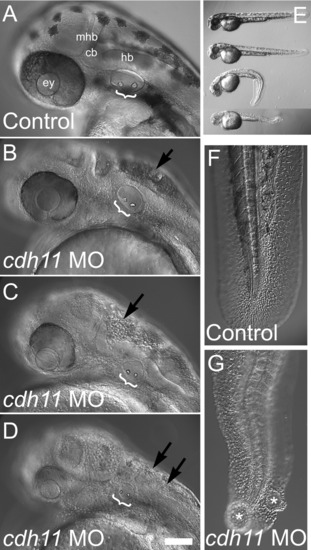
cdh11 loss-of-function neural and tail phenotype. Zebrafish were injected with control morpholino oligonucleotide (A, E, F) or cdh11 antisense morpholino oligonucleotide (B-E, G). Embryos (48 hpf) were imaged using DIC microscopy (A-D, F, G; Nikon diaphot 200, Plan 20× 0.4NA objective using DIC) or a stereo microscope (E; Leica MZ12) using a SPOT Camera (Model 2.2.0 Diagnostic Instruments and Spot software). Increasing severity of cdh11 loss-of-function phenotype is illustrated. B: Slightly affected embryo; C: moderately affected embryo; D: severely affected embryo. Brackets highlight otoliths within the inner ears. Effects on melanocytes, the neural axis, and eye development were also evident. In E, a control-injected embryo is at the top, and the three embryos below are cdh11 morphants with slight, moderate, and severe phenotypes. Higher magnification images of tails (F, G) are shown to illustrate that severely affected cdh11 loss-of-function embryos have significant tail curling, cyst formation (labeled with asterisk in G), and rounded cells indicative of a dysadhesion effect during tail formation. Also, evidence of cellular disorganization and possibly dysadhesion was detected in the brains of all affected cdh11 antisense morpholino oligonucleotide-injected embryos (arrows indicate many rounded, cellular structures fill the fluid space of the hindbrain, fourth ventricle; see B-D). Scale bar in D =100 μm for A-D, F,G. ey, eye; mhb, midbrain-hindbrain boundary; cb, cerebellum; hb, hindbrain.
|

